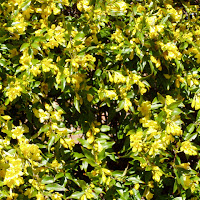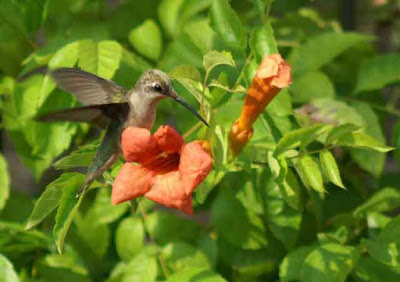As I noted in a previous article, bird-watchers who want to see them up close usually attract them with bird feeders, houses and baths. There are, however, other ways of enticing them that shouldn't be overlooked. The landscape can be transformed into a bird sanctuary by including plants that provide food and shelter. Ornamental vines are important components of such a plan.
Here are 5 ornamental vines that birds find irresistible.
A Clarion Call For Hummingbirds
Trumpet Vine (pictured above) or Trumpet Creeper (Campsis radicans) is a climbing deciduous vine native to the southern United States. Travelers may have noticed it growing up and over fences and signposts along the highway. Large, bright yellow, orange to red trumpetshaped flowers appear from midsummer to fall. Campsis is popular world-wide for its stunning flowers, and because it attracts hummingbirds.
Campsis is cold-hardy in USDA climate zones 4 through 10. For best results, plant in full sun, well-drained soil with average to poor fertility. Plants are drought tolerant when established and heat-loving. It is best planted next to a permanent structure for support.

Yellow Garlands of Spring
Gelsemium sempervirens – known as Carolina Jasmine, Carolina Jessamine, Yellow Jasmine, and whatever else comes to the viewer’s mind – is another great native plant that provides nectar for the birds. It’s grown mostly for its glorious early spring flowers. Southerners wax nostalgic about it. Unfortunately, it is cold hardy only in USDA climate zones 7 through 9. The flowers usually appear before the hummingbirds arrive, so is best planted as a nectar source for other species. I’ve written much more about it in a blog article, Carolina Jessamine – The Yellow Garlands of Spring.Wild and Wonderful
 Most of us think of English ivy and all its varieties as a rampant but boring evergreen covering, or worse. But look closer and you’ll find a plant with lots of interesting variations that can not only provide mass ground- or wall covering, but also shelter and an ornamental food source for birds.
Most of us think of English ivy and all its varieties as a rampant but boring evergreen covering, or worse. But look closer and you’ll find a plant with lots of interesting variations that can not only provide mass ground- or wall covering, but also shelter and an ornamental food source for birds.Some folks dislike ivy for it's vigorous growth habit. The very characteristic that makes it a fine ground cover can render it unwelcome; it covers ground. It's true that ivy can be troublesome if completely unchecked, but ivy does not damage trees or sound structures. It isn't a parasite. It cannot harm a mature tree, but it could outlive an old one. It cannot collapse a sound building. Ivy is a major food source for many birds, and the fruits ripen up just in time to fatten them before winter arrives. Hedera ivies also provide abundant shelter.
It Keeps Institutions From Crumbling
 Boston Ivy - Parthenocissus tricuspidata - is native to east Asia, not Massachusetts. Each leaf is composed of three lobes. In juvenile foliage, each lobe is very distinct. It is a vigorous climber, as anyone who has seen it on a wall knows well. Fall brings bright colors of yellow, orange, red or burgundy. The walls it adorns seem draped in a majestic tapestry. It is also widely used to cover trellises, pergolas, and as an ornamental ground cover for erosion control. Small flowers appear in July or August followed by fruits in October or November, and birds love 'em.
Boston Ivy - Parthenocissus tricuspidata - is native to east Asia, not Massachusetts. Each leaf is composed of three lobes. In juvenile foliage, each lobe is very distinct. It is a vigorous climber, as anyone who has seen it on a wall knows well. Fall brings bright colors of yellow, orange, red or burgundy. The walls it adorns seem draped in a majestic tapestry. It is also widely used to cover trellises, pergolas, and as an ornamental ground cover for erosion control. Small flowers appear in July or August followed by fruits in October or November, and birds love 'em.Boston ivy grows in any fertile, well-drained soil, and thrives in USDA climate zones 48. In other words, it'll probably perform well in your garden.
A Native With Great Possibilities
Virginia Creeper - Parthenocissus quinquefolia - is native to many parts of North America, from Quebec to Florida, and westward to Colorado. It's a member of the grape (Vitaceae) family. The relationship is easy to see when you look at the flowers and fruits, but I don't recommend them for human consumption. Each leaf is composed of five leaflets. It climbs vigorously. Fall brings bright colors of yellow, orange, red or burgundy. The depth of fall color seems to depend upon available sunlight. Virginia Creeper is widely used as an ornamental ground cover, but its fall color and ability to cover walls, trellises and pergolas makes it popular as well.Virginia Creeper thrives USDA climate zones 3-9, a broader range than Boston ivy will tolerate. Its fruit and dense growth habit make it very attractive to birds for food and shelter.
These suggested vines, along with many bulbs, perennials, annuals, shrubs and trees will be welcome additions to your landscape from the birds' points of view.
Remember to think outside the bird feeder when you plan to feed the birds.
Return to GoGardenNow.com














